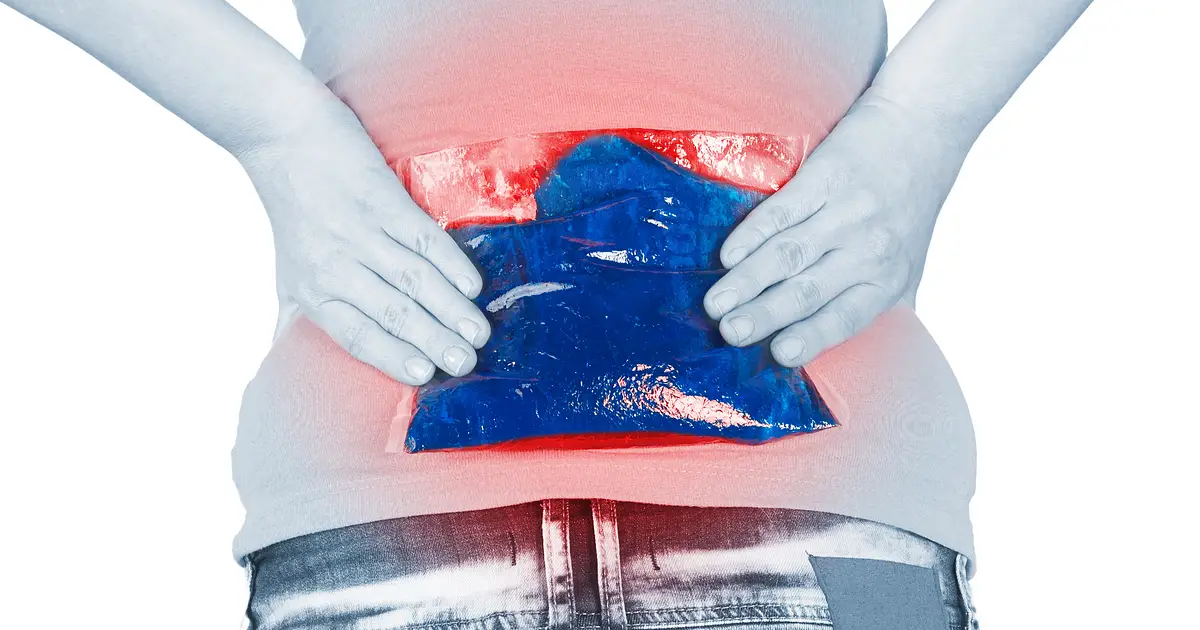Precautions And Safety Tips
Heating pads are effective for pain management, but they can be dangerous when used improperly. Here are a few safety tips to avoid injury.
- Dont place a heating pad or heated gel pack directly on your skin. Wrap it in a towel before applying to skin to avoid burns.
- Dont fall asleep using a heating pad.
- When using a heating pad, start on the lowest level and slowly increase the heat intensity.
- Dont use a heating pad that has a cracked or broken electrical cord.
- Dont apply a heating pad to damaged skin.
Cooling Down To Prevent Inflammation
We can treat injury or tissue pain with a hot or cold pack, or sometimes alternate the two.
Cold therapy should be used for injuries that result in swelling and inflammation such as joint sprains, muscle strains or bruises. The objective is to slow blood flow to the area and prevent the effects of the injury. Gel packs that can be kept in the freezer, coolant sprays or even a bag of frozen veggies will do the job.
It is important to avoid holding ice in direct contact with the skin for long periods as this can cause skin damage. It is best to wrap ice in a cloth and then apply it.
Cold therapy is most effective in the immediate or acute phase of pain when swelling and inflammation first kicks off. Typically, the treatment should be applied for about 20 minutes and can be reapplied every two hours for a few days. After that, the injury should be well into the healing phase and the swelling and inflammation will subside.
Cold therapy, or applying ice, is often used in conjunction with rest, compression and elevation, known in first aid by the acronym RICE.
So, ice can be useful when we want to limit the initial swelling and pain, since too much or prolonged swelling can impede the healing process. But with less severe injuries like minor sprains and strains, inflammation is part of the bodys healing process and continuing cold therapy can be a barrier to recovery.
Aquatic Therapy And Whirlpools
Physical therapists often recommend aquatic therapy including exercises done in warm, therapeutic pools for back pain. The buoyancy of the water helps alleviate strain on the joints to encourage strengthening and gentle stretching of the muscles. Even floating in warm water can help relax muscles and release tension as well as increase circulation, according to the Arthritis Foundation. With home whirlpool baths, try aiming the jets directly at your sore spots for a soothing underwater massage.
Read Also: Aleve And Back Pain
Can You Use Both Cold And Warm Compress
When it comes to treating sinus headaches and relieving congestion, you dont really need to choose between cold and warm compress. In fact, its better to use both alternately.
Alternating between hot and cold compresses is known as contrast therapy, which has numerous benefits for physical therapy. For sinus pain, this treatment can relieve a lot of the pain youre experiencing and should be done repeatedly in a day.
Heres how to do it:
Should You Use Heat Or Ice For A Stiff Neck

Applying both heat and ice to your neck can help ease pain in the area. But which should you choose?
Ice therapy used for too long can result in damage. If you have diabetes, or another condition that reduces your sensitivity you should avoid using ice therapy. Also, if you have poor circulation, ice therapy should not be used. Individuals with cardiovascular or heart disease should consult with their doctor before using ice therapy.
Heat therapy can be used for longer periods of time but there are still risks to watch out for. Certain conditions may make you more prone to burns or complications from the heat. If you have diabetes, multiple sclerosis, dermatitis or a vascular disease, you should not use heat therapy. Individuals with heart disease or who are pregnant should consult with their doctor before using heat therapy.
In general, cold therapy is usually appropriate when you have acute pain and inflammation in an area. The cold can help reduce the swelling which may be contributing to the pain.
Heat therapy, on the other hand, is often helpful when you have stiff joints. This makes it a good choice for individuals with a stiff neck.
Have you tried heat or cold therapy? Which do you prefer? Leave a comment on our post on .
Also Check: Does Aleve Work For Back Pain
Low Back Pain: Ice Or Heat
Should you apply cold or heat to treat lower back pain? Cold packs reduce swelling and inflammation, and help reduce pain. Although most muscle injuries respond well to alternating heat and cold, back pain may respond better to heat1.
The best solution is what works best for you. Try using heat to relax the muscles, then apply cold. If cold does not help, stick with heat, but dont overdo it.
Heat: Moist heat works best. Use hot packs, baths or showers, or an all-day heat wrap available in pharmacies. Heating pads are dry heat but convenient. Apply heat for 15 20 minutes at a time.
Cold: A frozen towel, an ice pack or a homemade slush pack, a bag of frozen vegetables are all options to ice your back. Ice at least 3 times a day. Icing remedies from WebMD.com.
Alternate: Switching between heat and cold works best for many people. Use either for 15 20 minutes, wait a few hours and alternate.
Citations
Can I Use Ice Therapy
Ice therapy doesnt have many of the limitations of heat therapy. For example, its not typically as dangerous to people with other health issues. However, it can be a problem for people who have sensory issues that make it difficult to sense pain. This includes people who have diabetes, as nerve damage may have impacted their sensitivity to extreme temperatures. Its important to be able to see and feel what the ice is doing, so you dont accidentally let it sit on your skin too long to cause damage and, ultimately, more pain. Its also not recommended for people who have poor circulation.
As we mentioned previously, its important to understand the source of your pain and which treatment is going to be the most effective. Ice therapy is not useful for individuals who are trying to treat stiff joints or muscles because it will not loosen up stiff areas it will have the opposite effect!
Also Check: Is Aleve Or Ibuprofen Better For Back Pain
When To Use Cold Therapy For Back Pain
- Acute back injury: Ice for back pain can be an effective pain reliever if you are experiencing an acute injury. For example, maybe you strained the muscles of your lower back by lifting something too heavy. The cold from the ice can help to reduce inflammation in the affected area. If you want to address an acute injury, its best to apply cold therapy within two days of the injury.
- Soreness from exercise: Exercise can help alleviate and even prevent recurrent back pain. Depending on the types of exercise you are doing and the intensity, you might feel sore after a workout. The cold can help ease the strain and tension in your muscles.
- Sciatica: Sciatica is the name for pain in the sciatic nerve, which begins in the lower back and travels down through the buttocks and the legs. If you are having a sciatica flare-up, immediate application of cold therapy can help to reduce the pain and inflammation. Cold therapy may also help reduce the muscle spasms associated with sciatica.
A Few Tips And Rules Of Thumb For Contrast Bathing
- Stay warm. You generally want to be more thorough with your heat: at least a minute, but as long as five minutes depending on how efficient your heating method is. Heat is more comforting and relaxing than cooling, obviously, and inadequate heating is the most common thing people do wrong with contrasting.
- Finish with cold. You should usually finish a contrast session with cold, particularly if you suspect that you might be a little inflamed. Never finish with heat if youre concerned about aggravating inflammation. You might choose to finish with heat if your priority is to have a more relaxating experience.
- Stretch when hot. Not that stretching is all that its cracked up to be, but if you choose to stretch, do it after or even during the heating. If you have to stop heating to stretch, reheat after stretching before moving on to the cold.
- Dial it up as you go. It is desirable to increase the intensity of the contrast as you go: that is, the hot gets hotter and the cold gets colder.6
You May Like: Will Aleve Help Back Pain
Heat Therapy Stimulates Blood Flow
Unlike cold therapy, heat therapy speeds up the blood flow and can be a gentle suggestion to your body to begin the healing process. You might find that heat therapy helps sooth sore muscles and relax muscle spasms especially with an older injury.
Using heat therapy reduces the pain by not only relaxing your muscles, but also by increasing the flow of lactic acid. This fluid often slows down in areas with decreased blood flow, but its removal is necessary for improving range of motion and decreasing pain. Paired with hydration, heat therapy can help you heal from pain from an ongoing injury or to relax sore muscles and stiffness from the body.
If the injury causing pain is severe, be sure to talk to your orthopaedic specialist to ensure that a more active approach to your pain management isnt necessary.
Tips When Using Heat And Ice Therapy
If you plan to regularly use heat and ice therapy, it can be helpful to have both options on hand. If you work out first thing in the morning, you can keep an electric heating pad plugged in by your bed. Wake up, get some heat on your back muscles, then dive into your workout routine. It can be helpful to keep a few different cool packs in the freezer so they will be ready for use whenever you need them. Cold showers and hot baths can also be a beneficial way of augmenting your go-to cold and heat therapies.
Whether you are doing individual cold or heat therapy or a combination of both, always remember to protect your skin. Set a timer for your therapy sessions to ensure you do not leave the ice or heat on your back for too long.
Also Check: Aleve Or Advil For Lower Back Pain
The Donts Of Applying Hot Packs For Arthritis
- Now, it isnt difficult to guess that heat can make acute inflammation worse. Heat should NOT be applied in acute pain, acute injuries, and in bleeding, even when these occur to an arthritic joint. Applying heat to a fresh injury will only worsen the pain.
- Do not use heat if you have any open wounds or substantial bruises
- Not recommended for patients with diabetes
Note: Tiger balms and other capsaicin-containing topical ointments are only spicy that is they make you feel hot they do not increase heat physiologically. They distract our mind from pain they do not affect pain.
When To Use Caution

Paraffin wax treatments supply moist heat but overheating can cause burns.
Use caution on areas with decreased sensation if you have neuropathy or Raynauds syndrome. Extreme temperatures can damage skin.
Wonder if its safe to use ice when youre burning up with fever? Theres nothing wrong with using cold to bring down a fever, says Dr. Kriegler.
Don’t Miss: Aleve Good For Back Pain
Continue Learning About Back Pain
Important: This content reflects information from various individuals and organizations and may offer alternative or opposing points of view. It should not be used for medical advice, diagnosis or treatment. As always, you should consult with your healthcare provider about your specific health needs.
When Should I Use Ice Or Heat For My Lower Back Pain
Applications of cold alone or along with pain medications can help relieve back pain. Typically, cold is used within the first 48 hours after your back symptoms start. A cold pack is applied to the painful area for 5-10 minutes at a time. Applications of heat alone or along with pain medications are often helpful in relieving back pain. If your back pain has lasted longer than 48 hours, use a heating pad or take a hot shower or bath, which may help relieve your symptoms.
Don’t Miss: Tylenol Or Aleve For Back Pain
Use Caution If Youre Pregnant
If youre pregnant and have back pain, its safe to use a heating pad. You should avoid prolonged exposure since overheating can be dangerous to a fetus. It can lead to neural tube defects or other complications.
This is more probable in a hot tub or sauna, but err on the side of caution. Use a heating pad on the lowest setting while pregnant, and only for about 10 to 15 minutes.
Since heating pads decrease pain signals and increase circulation, use the pad soon after developing painful flares or stiffness to speed the healing process.
When You Should Not Ice Or Heat An Injury
Heat is well known for making swelling worse. Ice is well known for making muscle tension and muscle spasms worse, and more painful. Because of this, if you use the wrong method of treating an injury, you can do mild to moderate harm to the area.
Ice and heat are both controversial in contradicting environments and situations: Ice is pointless when you are shivering, and heat is pointless when you are sweating in the summer heat. Not only is it pointless, it can also be interpreted by the body as a threat, which can significantly increase the amount of pain experienced from the injury.
You May Like: Aleve Or Ibuprofen For Back Pain
How To Apply Ice
There are several different methods for icing your lower back. For instance, you can perform ice massage therapy, which entails gently rubbing a chunk of ice over the affected area to help numb your back and reduce any pain. You can also apply ice without any massage if you have a store-bought or makeshift cold compress, such as a bag of frozen vegetables.
If you use ice for back pain, remember not to leave any ice directly on your skin for a prolonged period to avoid potential burning. If you plan to leave the cold compress in place, wrap the ice pack in a thin washcloth or a couple of paper towels to create a layer of protection between the ice and your skin. You can ice for up to 20 minutes at a time.
Ice Your Back Immediately After Exercise To Reduce Muscle Soreness
Muscle soreness and back pain can occur from extensive workouts, trying a new type of work out, or even from excessive walking. Soreness from these activities may start on the first day but typically continues to peak until the third day.4 This phenomenon is called delayed onset muscle soreness and can cause significant inflammation and pain in your back.
When you have back pain from exercise or exertion, use cold therapy immediately after the activity to reduce tissue damage, inflammation, and pain. After a 24-hour period, use heat therapy to encourage tissue healing.4
Read Also: Back Pain Advil
Cold Therapy Vs Heat Therapy For Chronic Lower Back Pain
Unlike acute lower back pain, it is a bit more difficult to nail down when cold vs heat is best for chronic low back pain.
Recommendations should be determined from your Doctor based on his/her assessment of your particular source of chronic pain and treatment options.
Low-level continuous heat is often recommended for chronic back pain relief.
Heat before exercise can help warm-up the muscles and lessen pain during your back exercises.
Cold therapy is also very helpful after exercise to reduce muscle soreness.
The Benefits Of Heat For Injury

Heat therapy works in the opposite mannerit is a vasodilator, which increases circulation by expanding the blood vessels. This reduces pain and relieves cramping or aching muscles.
It also draws nutrients to the injured area, aiding the healing process, while helping the bodys cells get rid of waste products.
Unlike ice, heat can make inflammation worse.
Also Check: Does Aleve Help Back Pain